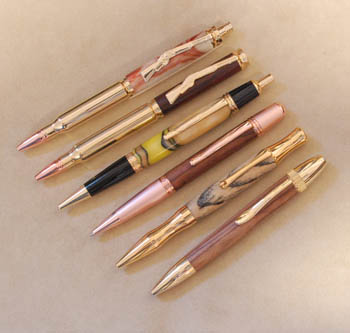
Some of the best businesses in our industry were started by woodworkers who said to themselves: “There’s got to be a better way to do this.” Tom Hutchinson is one of those guys. He’s the president and owner of Hut Products Inc. now, but he started as an expatriate from academia (anthropology) who picked up an old lathe while doing a stint as a carpenter. It was actually an old Shopsmith, but he used it as a lathe to learn how to turn.
But turning big bowls and other large projects lost its appeal for him, so he started concentrating on small turning projects. He wouldn’t get to pens-the primary product line for Hut-for years. First he had to satisfy his curiosity about a certain matter.
As he learned about turning, he got very frustrated by the finishes that were available for his projects. He started studying finishes and, after several years of research, decided that he wanted a solid finish that he could use as part of the turning process. That meant some kind of wax*, but something with a high polish content. He finally hit upon a mixture of proprietary polishes combined with carnuba wax and molded into a bar. Thus the first Hut Bar was born.
He thought he had something pretty darn close to perfect with the Hut Bar and startedselling it here and there. Somehow the folks at Shopsmith found out about this finish and contacted, giving him a long lecture about how to market woodworking products. They ordered and resold the Hut Bars and the business really started taking off. When Woodcraft purchased 20 of Shopsmith’s retail stores, they, too, got very interested in the Hut Bars. They ordered even more of the finish and Tom got very busy. An executive at Woodcraft also lectured him about product presentation, so he tossed out the muffin tins that were used as molds for the bars. He got a professional to make him a proper mold and the rest, as they say, is history.
About a year after his bars went national, a customer called him up and asked him if he had ever used his Hut bars for pen turning. The customer convinced him that Hut was perfect for pens, so he contacted a company that sold pen mechanisms. This was back in 1991 and he was surprised to get ten mechanisms in the mail with no instructions about what to do. “So I paid them $4.95 for the worst set of instructions I’ve ever seen in my life,” says Tom.
He turned about 8 pens and finished them with the Hut bar. He had to admit, it was a good combination. Clearly pen turners needed more guidance than they were getting, so he decided to start expanding his business into pen turning supplies to compliment his finishing bars. That, too, took off.
About five years ago, Tom recruited his son David into the business and the product lines expanded profitably. It’s difficult to imagine that finishing chemistry might run in someone’s family, but Tom’s son developed the only finish that has been able to knock the Hut Bar out of the top spot: Crystal Coat.
While this finish is a liquid-technically a friction finish– David figured out a way to suspend high solids content the finish. In fact, about 60 percent of Crystal Coat is made up of solids. The real trick, Tom explains, was getting such disparate elements like shellac and carnuba and alcohol and mineral spirits to stay together in this finish. Somehow, he made it work.
His son has since started his own computer repair business, but Tom continues to innovate with the products he offers pen turners. At one point, he had more kinds of exotic woods than anyone else he could find. He had a wall of 300 different materials for pen turning, everything from apricot to zebrawood. He has since trimmed back on what he offered because, while he collected some very exotic woods, many weren’t all that great for pens. Mango wood, for example, is just about as bland a wood as you will ever see, says Tom.
His favorite wood for turning, though he can’t get it anymore, is Honduran rosewood burl from Belize. That, he says, is the single most beautiful wood he’s ever seen. It’s hard, it’s easy to work with, it’s durable and it finishes exquisitely.
In the meantime, pen turning has really taken off. Pens have become status symbols, much like watches used to be. And pen turning is a pretty easy way to get into woodturning. “Turning a pen is very close to instant gratification,” says Tom, “You can have a finished functional product in much less than an hour.”
*In the course of his research, Tom was astounded at the range of waxes available, e.g. pine bark wax, rice hull wax, etc.
– Bob Filipczak





